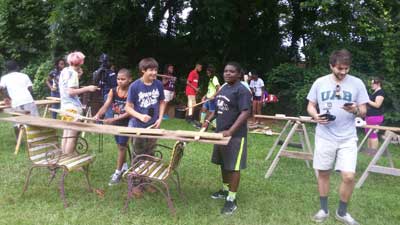Poverty in Alabama’s Black Belt is as deep and pervasive as the rich soil the region is known for. It is where the median income languishes at $28,656, far below the statewide average of $42,081. It is where only 46 percent of high school seniors go on to college.
But now, almost 9,300 middle school children in 50 schools across the Black Belt will have a greater chance of getting a college education, thanks to a new program called Gaining Early Awareness and Readiness for Undergraduate Programs (GEAR UP) Alabama.

Last fall, the U.S. Department of Education awarded a multi-million dollar GEAR UP grant to UAB’s School of Education as part of a national initiative to increase academic achievement in impoverished communities.
“We want to increase the number of students in the Black Belt region who apply, are accepted and then attend [college], says UAB Associate Professor Larry Tyson, Ph.D., the grant’s principal investigator.
The grant is $24.5 million, plus another $24.5 million in matching funds and will pay for educational programs that target sixth and seventh graders in 21 school districts across the Black Belt and continues through their first year of college.
To do that, GEAR UP organizers have divided the state’s Black Belt into five regions. Each region has one regional coordinator except Montgomery County which has two. The regional coordinators oversee GEAR UP activities for the area, and every middle school has a team consisting of an administrator, teachers, a team leader, a counselor, and a site facilitator to organize GEAR UP programs and academic enrichment opportunities at their school.
GEAR UP organizers then brought in representatives from Southern Regional Education Board (SREB) to assess each middle school’s academic program, Tyson says.
SREB is a nonprofit, nonpartisan group that works with member states to improve public education.
“They talked to teachers and administrators, district personnel, and each of our schools received a profile on their strengths and weaknesses in the areas of culture, rigor, school climate and teacher preparation,” says Tyson. “We did it because we wanted a baseline of where all of the schools were.”
Team leaders and site teams also attended professional development seminars organized by Kaplan K-12 Learning Services this summer to learn how to add more rigor to middle school courses, particularly in the areas of math and science, Tyson says. The team leaders shared that information with other teachers.
GEAR UP organizers are also consulting with ScholarCentric, a Denver-based teacher training company that will administer questionnaires designed to measure resiliency in children. The surveys will ask students about their experiences in the classroom in order to identify those most at risk for dropping out of school.
In addition, GEAR UP Alabama also aims to help families prepare financially for students’ college education through local partnerships with banks and nonprofits. Organizers, for example, have recruited Regions Bank as a partner to host workshops for families on financial literacy and saving for college. They also contacted Alabama Area Health Education Center (AHEC) and the Alabama Health Action Coalition (Al-hac) to conduct classes on nutrition and home economics to help GEAR UP families to save money on food.
“We are also looking for creative ways to offer scholarships to students who qualify,” Tyson says.
GEAR UP Alabama has already garnered support from the chancellor of Alabama’s community college system, Dr. Mark Heinrich, who has pledged tuition scholarships for any GEAR UP student who qualifies for community college and for GEAR UP parents who want to finish their degrees or acquire the education required to enter into the workforce.
Moreover, GEAR UP Alabama students will have access to program services such as mentoring and tutoring, as well as financial literacy and lifestyle management workshops through their first year of college, Tyson says.
This summer, GEAR UP Alabama middle school students attended academic camps paid for with grant funds, Tyson says. Each student had the choice to enroll in either a three-week STEM summer enrichment at their school or a residential camp at a local college or university.
“We’ve got to get kids learning all year round because the drop off is too much,” says Tyson, “Some of the [school] systems don’t have summer programs. We have to plug that gap.”